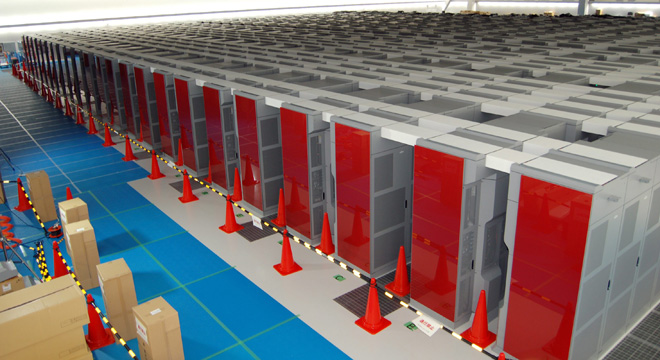The reigning champ has done it again: Japan’s record-breaking K Computer, located at the RIKEN Advanced Institute for Computational Science (AICS) in Kobe, Japan, again took the top spot on the biannual list of the world’s Top 500 fastest supercomputers, published Monday by computer scientists in the U.S. and Germany. The K Computer had occupied the number 1 position on the previous list, published in June.
This time though, the K Computer hit a new record: 10.51 Petaflops (10.51 quadrillion floating point operations) using the LINPACK test for determining supercomputer performance.
As such, it becomes the first machine in the world to hit that speed, a milestone considering that just three years ago, IBM’s Roadrunner computer became the first computer in the world to surpass 1 petaflop, Network World reported.
IBM’s Roadrunner, located at the Los Alamos National Laboratory in Los Alamos, New Mexico, now rounds out the top 10 at 1.042 petaflops, the same number it clocked in the June list. The best-performing American supercomputer, the Cray XT5 Jaguar at the Oak Ridge National Laboratory, in Oak Ridge, Tennessee, came in third place this year with 1.75 petaflops, also the same as it recorded in June.
In fact, the top 10 placeholders on the November 2011 list remained unchanged from summer, the first time in the list’s 18-year history that such consistency was achieved. None of them recorded increased performance except the K Computer, which, to be fair, had not been completely finished being built at that point, nevertheless clocking in an impressive 8.16 petaflops. Its theoretical peak is actually even higher than that, 11.28 petaflops, according to Wired.
But it is important to point out that supercomputing power is not stagnating: Far from it, combined, the supercomputers on the list reached 74.2 Petaflops, compared to June’s combined total of 58.7 Petaflops.
The biggest news out of the November 2011 Top500 list was actually to be found lower down the list, beginning with the second place supercomputer: China’s Tianhe-1A system at the National Supercomputing Center in Tianjin, which recorded 2.57 petaflops and was last year at this time the fastest supercomputer in the world at 1.27 petaflops. The lowest contenders had to best 50.9 Teraflops, compared to June’s minimum benchmark of 39.1 Teraflops.
China now has 75 supercomputers that made the top 500 list, up from just three a decade ago, Popular Science notes. That puts it in second place behind the United States as the country with the most high-powered computer systems, besting previous second-place holder Japan and all of the other top computing countries in Europe.
Still, it’s also worth mentioning that when it comes to the technology behind the various supercomputers around the globe, the dominant players are still American companies: IBM and HP dominated the list for system-share, at 44.6 percent and 28.0 percent, respectively.
Supercomputers are used for a variety of functions, including complex climate modeling, weather forecasting, physics, plate tectonics, national security and basically anything that requires inputting and making sense of enormous amounts of data. They also require an enormous amount of real estate and power: 29 of the systems used over 1 megawatt of electricity, each one using enough to power 100,000 lightbulbs, CNET reports.









